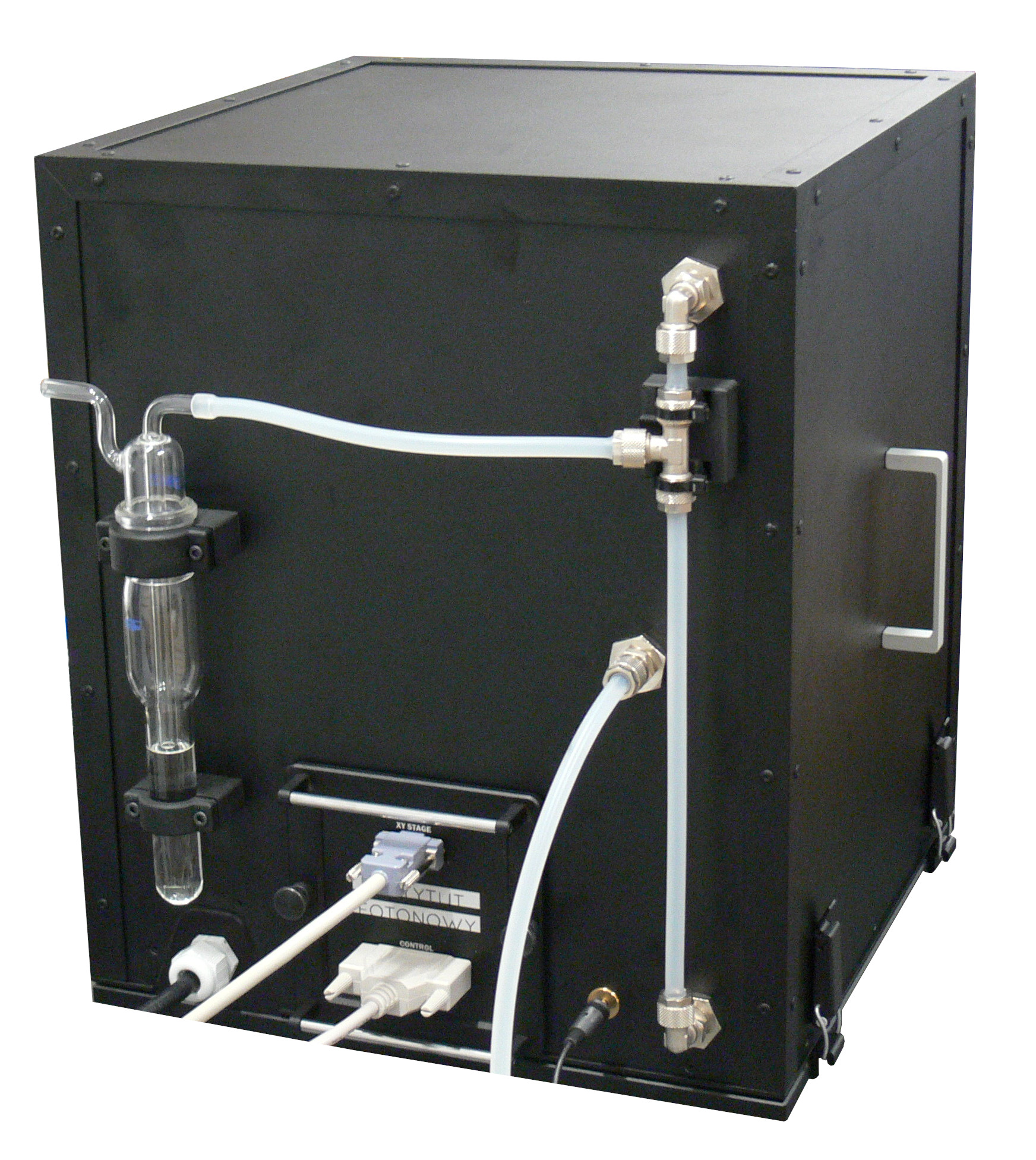The Electrochemical Kelvin Probe measures CPD (Contact Potential Difference) value and evaluates Work Function of electrochemical samples in contact with electrolyte.
Measurements of work function is particularly useful in semiconductor physics because they provide a position of Fermi level in examined material.
The Electrochemical Kelvin Probe, when coupled with a light source, measures Surface Photovoltage (SPV) of a sample when dry or wet interface is illuminated.
Electrochemical Kelvin Probe comes with a dedicated electro-chemical cuvette. There, a sample is floating on an electrolyte. The Kelvin probe tip approaches the exposed top side of the sample. This way, there is no electrolyte layer of top of the sample that can affect the measured CPD. Still, the bottom side of the sample remains in contact with an electrolyte.
Light can illuminate either top surface of the sample or bottom sample-electrolyte interface.
A possible chemical reaction on the sample-electrolyte interface will affect the measure value of CPD. Also a choice of Reference Electrode (RE) selected for the measurement will offset the CPD.
Optionally, the Electrochemical Kelvin Probe may be equipped with the inert gas flow system to provide neutral environment inside the Faraday’s cage.
The Electrochemical Kelvin Probe set consists of:
- Controller unit,
- Kelvin Probe instrument with the Probe Tip,
- Electrochemical cuvette,
- Faraday Cage.
The Electrochemical Kelvin Probe instrument is equipped with:
- Protective bay to park the Probe Tip after experiment,
- Laser pointer to indicate the area directly,
- Light source that helps to handle the sample when the instrument is covered with the Faraday Cage,
- Laser barrier to precisely detect the Probe Tip distance to the sample,
- Golden Probe Tip,
- Sample holder for the Electrochemical cuvette,
- Electrochemical cuvette with the sample placed on top.
click the picture to enlarge
Probe Tip
The most important part of the Kelvin Probe instrument is the Probe Tip. The probe is fully designed and manufactured by Instytut Fotonowy. The reference electrode is made of Au mesh of 2.5 mm diameter. It provides high signal to noise ratio, even from a distance of 0.5 mm above the sample. Thus, it does not matter if the examined sample surface is rough or polished. The tip oscillations are generated with an electromagnet.
click the picture to enlarge


Electrochemical cuvette
The key element of the Electrochemical Kelvin Probe is the Electrochemical cuvette set, where the sample is placed directly on the top of the cuvette.


Sample illumination
Although you may use any light source at your disposal to provide sample illumination, it is convenient to opt for our LED Revolver or Xenon Lamp with a Monochromator because FotoGUI software handles them already and carries out automatic experiments with LED switching or wavelength scans.
click the picture to enlargeLight delivery to the sample
Light delivery may be performed in two manners: from the top, where a sample’s surface is illuminated and from the bottom where the sample-electrolyte interface is exposed to the radiation.
- Light delivery from the top

- Light delivery from the bottom

Several types of liquid lightguides from Lumatec may be used to provide the sample illumination.
Faraday Cage
A Faraday Cage covers the entire instrument, shielding the setup from the ambient light and electromagnetic fields.
click the picture to enlarge
Gas-tight Faraday Cage with inert gas flow system
Since measurement of the CPD is often sensitive to environmental factors like temperature, humidity, dust and chemical contaminants, Kelvin Probe may be placed inside the hermetic version of the Faraday Cage filled with the inert gas.
click the picture to enlarge
Laser barrier
The Kelvin Probe is equipped with the Laser barrier system. It automatically detects the sample top edge. Each time the probe approaches the sample being examined, an accurate distance between the sample surface and the Probe Tip is measured with 20 µm precision.
click the picture to enlarge
General:
- Weight: 15 kg,
- Size: 40x40x45 cm,
- PC connectivity: USB 2.0,
- Power supply: 230 V, 50 Hz or 115 V, 60 Hz,
- Measurement technique: 2-channel lock-in-amplifier,
- Laser barrier to automatically detect the substrate and prevent the tip from running into the sample,
- Auxiliary sensors: humidity, temperature,
- Small lamp,
- Laser pointer for examined point of the surface indication,
- Sample holders:
– Freely shaped solid state with top contact holder,
– Bottom contact holder,
– Electrochemical holder,
Faraday Cage:
- Standard / gas-tight with inert gas flow system,
Measurement unit:
- Bias voltage range: -5 ÷ 5 V,
- Voltage measurement resolution: 0.15 mV,
- Current ranges: 300 nA, 30 nA, 3 nA, 300 pA,
Probe Tip:
- Probe Tip type: Au mesh, 2.5 mm in diameter,
- Tip positioning resolution in vertical axis: 20 µm,
- Automated resonance frequency scanning,
- Adjustable oscillation amplitude,
- Automated removal of the parasitic current of the tip,
- Partial transparency for the light,
- Typical CPD measurement distance: 0.2 – 1 mm,
XY Table:
- Motorized, controlled via software,
- Size: 50 x 50 mm,
- Movement range: 50 x 50 mm,
Electrochemical Cuvette
- Cuvette types: standard/bottom optics,
- Electrode type: Ag/AgCl or other,
- Material of electrolyte container: PTFE,
- Sample substrate: Kapton insulating foil with holes or other,
Bottom optics cuvette
- Optical fiber: liquid waveguide,
- Mirror: UV-Enhanced or custom,
- Optical window: fused silica.












